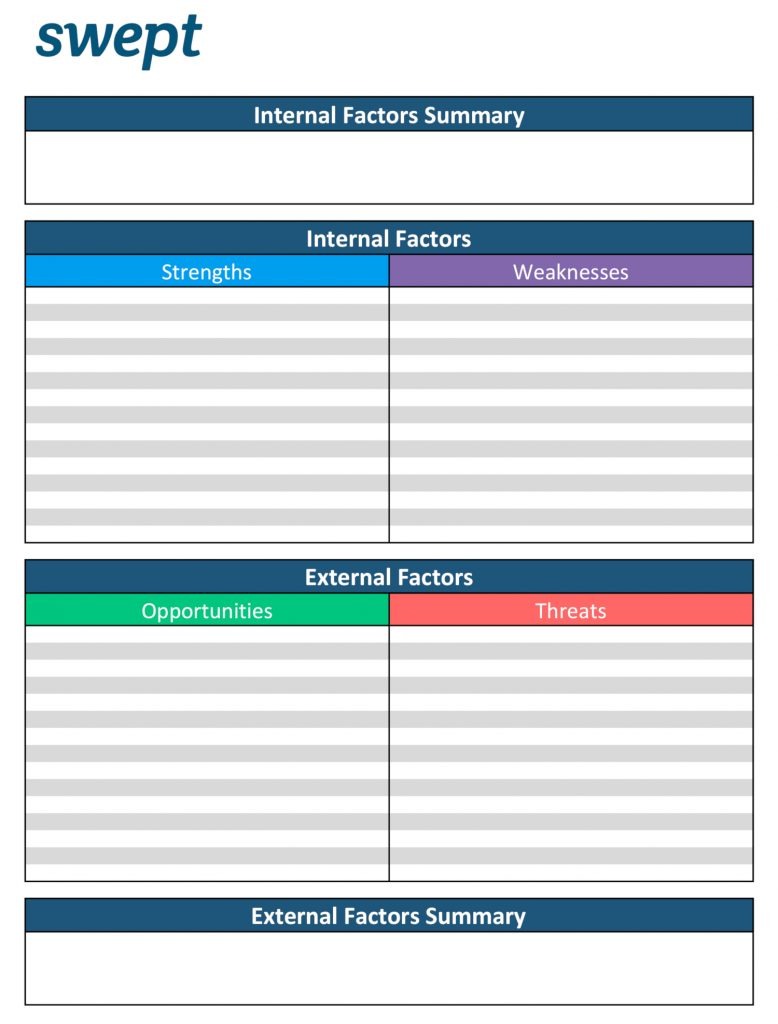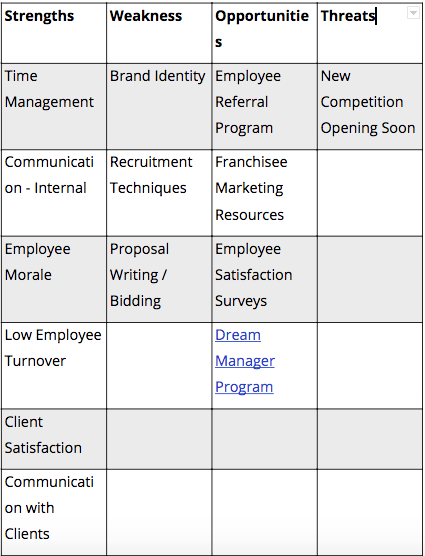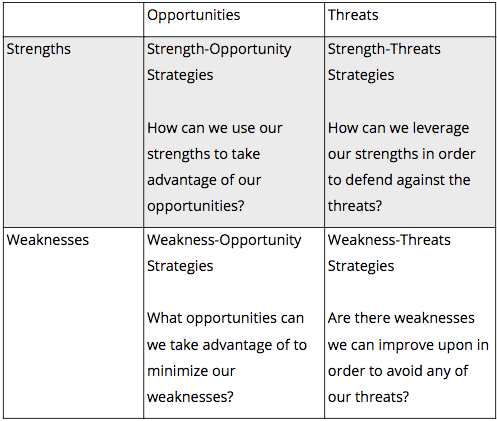Swept’s Guide to SWOT Analysis for Cleaning Companies
Intro to SWOT Analysis for Cleaning Businesses
We love seeing our clients (and everyone in the janitorial industry) succeed in their businesses, and a big part of that success is healthy growth. To help facilitate that growth, we’ve decided to dedicate this upcoming year to publishing content that delivers valuable insights, advice, and guides to help you find that success. Look forward to many eBooks, webinars, toolkits, and more in the coming months! Why let hindsight be the ONLY thing you see in 2024?
With that in mind, we present you with the first in a series of growth-driven content. And because we want this value in your hands sooner than later, we are putting out each chapter as they release, with a downloadable eBook available for free once all chapters are published. So without further ado…
Swept’s Guide to SWOT Analysis for Cleaning Businesses
Chapter 1 : Finding your Strengths
You’ve been wanting to work on your commercial cleaning company’s business plan, but finding the time is like finding a winning lottery ticket. In simple terms…difficult. We feel you, and want you to know, you aren’t alone. So we got our crack industry growth experts to help us compile this convenient step-by-step tool, that’s the perfect jumping-off point to start thinking about your overall business goals and strategy. It’s not overwhelming, it’s not too long, and we’ll walk you through how to use this tool one chapter at a time. At the end of the journey, you’ll have completed your very own in-depth analysis of your janitorial business. From there the next steps on how to grow and improve your company will be more clear than ever before.So, what is it?
It’s called a S.W.O.T. Analysis, and it’s a very valuable tool that’s used across a variety of industries, in companies big and small, and — it doesn’t cost anything! S.W.O.T. Analysis stands for:
S – Strengths
W – Weakness
O – Opportunities
T – Threats
Fun Fact: No one really knows for sure who invented the S.W.O.T Analysis! It is credited by some to Albert Humphrey who used the technique in the ‘60s and ‘70s at Stanford University to analyze Fortune 500 companies.
Why use it?
The S.W.O.T Analysis is often referred to as a “strategic planning technique,” but that’s just a fancy way of saying tool to help grow your business. The end goal is to run your cleaning company better. Running through the exercise of the analysis gets you thinking about both what you’re doing well, and what you could be doing better. It’s self-reflective, which is vital to changing your business in a positive way. We’re recommending this tool because it will help you identify areas where there are growth opportunities, where to increase efficiencies, and, hopefully, how to eliminate pain points and fix problems.
S – Strengths
This chapter will focus on identifying your company’s strengths within a S.W.OT. Analysis. It’s important here that we understand the difference between strengths and opportunities, which we’ll be identifying in the next chapter. So, let’s quickly look at both.
What is “a strength”?
A strength is something that your company does well, an aspect of your company that can be used to its advantage over the competition, or as leverage in getting new clients.
For example, does your company have high employee morale? If it does, that is a heck of a strength. The Commercial janitorial industry has the highest employee turnover rate of any industry in the world…. And by a crazy high amount…as much as 300%. To give some perspective, the second-highest turnover rate is 13% (in Software development)
So, if you have enthusiastic cleaners who love their jobs, and are excited to work for your company, that’s a major strength. Why? Because it means that you’ll have lower employee turnover, which in turn means spending less time and money on recruitment and training, plus you offer a more consistent service to your clients due to not being short-staffed.
What is “an opportunity”?
An opportunity is something that has potential to help your company, but you haven’t yet tapped into it. Strengths and opportunities can definitely overlap. Let’s revisit high employee morale once again. That also presents an opportunity for your cleaning company. Why? Because you could start an employee referral program, in which your happy cleaners are helping you to recruit other hard-working cleaners. There’s an opportunity to tap into high employee morale and design this program, but you haven’t done it yet. Listing your opportunities can be a great way to brainstorm ideas for taking your business to the next level. More on that in chapter two!
Back to strengths. Let’s get started on identifying yours.
Answering the following questions can help you to identify your cleaning company’s strengths:
- What are we good at as a company?
- What do our clients compliment us on?
- What do our cleaners like about working with us?
- Are we part of a franchise that offers any kind of support?
- Who supports us?
- What are we proud of?
Another great question: Have you already turned around any of your pain-points into strengths?
If your company uses janitorial software like Swept, that would definitely be a strength since it improves efficiencies in so many areas and eliminates pain-points for commercial cleaning companies.
Fact 2: This tool is sometimes also known as a S.W.O.T. Matrix.
Example: My Commercial Cleaning Company’s S.W.O.T. Analysis
Swept’s Guide to SWOT Analysis for Cleaning Businesses
Chapter Two: Weaknesses & Opportunities

In chapter one we covered what the S.W.O.T. Analysis is, what it does, why it’s an important tool to help grow your business, plus we kicked things off by looking at the “S” — or, your cleaning company’s strengths. Chapter two will focus on how to identify your weaknesses, and on the opposite end of the scale, how to spot opportunities. So, let’s jump right in.
Weaknesses
Everyone knows what a weakness is — something that you’re not good at. Something that brings you down. Something that makes you less strong, less competitive. Weaknesses hold you back. Why is it so important to self-identify your weaknesses as a business? Because without doing so, you won’t be able to turn them into strengths. To solve a problem, you first need to realize there is one, right? It’s time to get humble. Consider the questions below when outlining your weaknesses in the S.W.O.T. Don’t hold back.
Psst: We’ll touch further on what you’ll do with the S.W.O.T. in Chapter Three.
But First…
The Difference Between a Weakness and a Threat
While similar in nature, weaknesses and threats as identified in your S.W.O.T. Analysis play different roles. Think of your weaknesses as something internal, that you have control over changing. Threats, on the other hand, are not things that are inherently “wrong” with your cleaning company, but come from the outside. Threats are external, but can still cause a lot of damage. Being proactive and identifying these threats helps you to brainstorm ideas around avoiding the threats, or at least making the best of them. One big example could be a new competitor opening up in your area. While you can’t control this from happening, you can have a strategy in place on how you’ll compete with what they have to offer. But more on that in the next chapter.
Pinpoint Your Weaknesses by Answering the Following Six Questions:
- What could we do better?
- What’s holding us back from doing our best?
- What do our clients sometimes complain about?
- What do our cleaners not like about working with us?
- Are there opportunities we are not taking advantage of? If so, why?
- What are some of the reasons we’ve lost cleaning contracts?
Opportunities

In chapter one, we explained the difference between strengths and opportunities. Opportunities are typically external factors that could be tapped into that will give your janitorial company a competitive advantage. Opportunities can range from applying for a grant for funding your company, to simply not using your own cleaners as recruiters. In the last chapter we used the recruitment idea as the main example, so let’s expand. Why is this an opportunity?
The Recruitment Program Example
You have cleaners working for your business that are rockstars who do their jobs well, and love working for your cleaning company. Yes, we know this isn’t the case for every single employee, but likely for a handful. These rockstar cleaners are the perfect people to help recruit other, like-minded, hard-working cleaners to your company. You, as a business owner, have a major opportunity to design an employee-led recruitment program. This is an opportunity because it’s something that could help grow your business. It’s an opportunity because you’re not already doing this, but you could. Self-reflecting and identifying opportunities is an amazing way to brainstorm some seriously smart ideas for your company. So let’s get started.
Learn About Your Opportunities by Answering These Questions:
- If you’re part of a franchise: What tools and support systems are you not taking advantage of?
- How could your cleaners help you to find more cleaners?
- Are you currently asking for client testimonials?
- Are you currently asking clients for feedback?
- Do you do employee surveys?
- Do you ever gather information on your competitors?
- Are you using janitorial software?
- How do you find new clients?
- Are there any external support systems that could help my business? (I.e. associations, groups)
Turning Opportunities into Strengths: One Final Example
One easy example of turning an opportunity into a strength would be identifying an industry association for business owners that you could join. Associations often provide valuable information on business insurance, grants and funding, mentorship programs, and more. Taking advantage of this opportunity will allow you to tap into these support systems and learn how to better grow your business.
Swept’s Guide to SWOT Analysis for Cleaning Businesses
Chapter Three: Threats

In chapter two we took a deep dive into the middle section of the S.W.O.T. Analysis — the weaknesses and opportunities. There we talked about the differences between weaknesses and threats; specifically how weaknesses are internal and threats are external, and how to identify your weaknesses. From there we looked at opportunities, which are typically external, and how to turn them into competitive advantages for your cleaning company.
Now, we’re on the last letter of the S.W.O.T. — Threats. Sound scary? Most threats are only scary and unpredictable if you never take the time to identify them in advance, and be proactive about how they could affect your business. By doing a S.W.O.T. Analysis, you’re already ahead of the game.
Threats: Where to Look & What to Consider
We want to help you identify potential threats, within reason. While it is always important to have general emergency (and contingency) plans in place for your business, when you look at external threats in the context of a S.W.O.T. Analysis, you want to be realistic (and specific) to your industry and geographic area.
Appropriate Threat Example: A New Cleaning Company Opens Near You
Inappropriate Threat Example: A Natural Disaster
Something like a natural disaster can be devastating, and would definitely affect your business, but it would also affect everybody else. The threats we want you to identify here are more specific to your cleaning company or your industry as a whole, and are situations where you can take steps to either avoid the threat completely, or at least make the best of it.
You can’t control if another cleaning company opens shop in your area that will be going after similar clients. However, you CAN keep up on competitive reviews of other cleaning companies, read business news to be the first to know when they’re coming in, and research their strengths in advance to make sure you’re offering something better than the competition.
To identify the right kind of threats start by asking, (and finding answers to) some questions specific to your geographic area, and your industry.
- Are new competitors moving in? How often?
- Are competitors trying to recruit cleaners from your company?
- Are competitors offering better rates or wages?
- Is your employee benefits package competitive?
- Are there ever threats to public transportation for your workers? Strikes?
- Are there external safety threats that stop your cleaners from showing up?
- Are there outside threats that compromise the quality of your work?
- Has a new product or technology emerged, making your service less valuable?
- Are there ever supply shortages that stop your cleaners from doing their jobs?
Threats: How to Deal With Them

Depending on the threat, a solution could be as easy as simply having a backup supplier on call for certain products. Others, aren’t so easy. In the example of an impending public transit strike, you would need to be proactive and put together a contingency plan, ideally that stems from chatting with your management and supervisory team. Get everyone together to brainstorm how to tackle these threats — after all, you and your team know the business better than anyone.
If you’re having difficulty coming up with certain solutions, it may be helpful to call in a consultant who specializes in the affected aspect of your business. For example, if you’re really not sure how to do a competitive review of other companies’ wages and benefits packages, there’s nothing wrong with hiring a human resources (HR) consultant to help complete that task and tighten up any other HR-related issues for your cleaning company (like employee handbooks, onboarding, etc). Bringing in professional help can give you a serious leg up on the competition.
I’ve Completed the S.W.O.T. — Now What?
Congratulations — you’ve taken the time to analyze your business in an effort to improve and move forward. That’s a super important first step. Now, it’s time to further strategize based on what you learned completing the S.W.O.T.
Looking at ways your janitorial company’s strengths, weaknesses, opportunities and threats interact with each other is the next step to building strategies on how to improve and grow.
A table like the one below (usually referred to as a T.O.W.S. Analysis) will help you start thinking up these new strategies:
Answering these questions will help you to build a strategic plan. We recommend that the strategic plan has clear goals, tasks delegated to both yourself and other team members, and set deadlines to review everyone’s progress. Monthly or quarterly reviews are a great way to track your progress and measure your success.
And now we come to the end of our guide to SWOT Analysis. We hope you’ve found this to be, not just helpful, but aspirational for you and your business.
Swept is dedicated to highlighting stories that touch everyone in the janitorial industry. Having started as a commercial cleaning company ourselves, our hearts go well beyond the janitorial software we offer.


